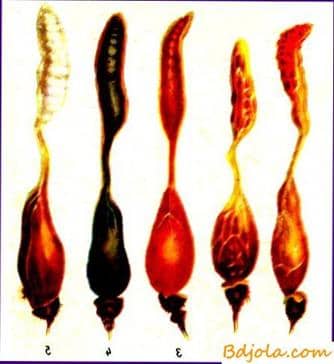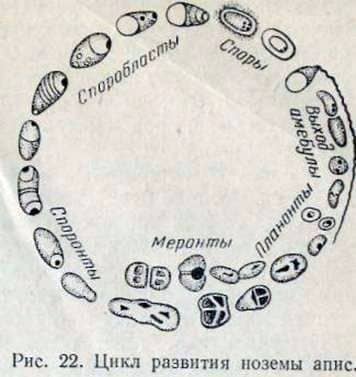
Nosematosis is an invasive disease accompanied by a disorder of the intestine and changes in the midgut of adult bees and queens.
Economic damage. In northern and central regions, this disease causes great harm – causing death or a strong weakening of bee colonies.
The causative agent of the disease. Nosema – Nosema apis – intracellular parasite of epithelial cells of the midgut. Sometimes it affects Malpighian vessels, ovaries, submandibular glands, hemolymph
In external conditions – outside the bee’s body – the noceme is preserved in the form of a spore. Spores of nostrils strongly refract light, have a strictly oval shape, a length of 5-6 microns, a width of 2.2-3 microns.
Outside the spore is covered with a dense, chitinous shell, resistant to staining. The cytoplasm of the spores is compacted, with a low water content. In the cytoplasm there are two nuclei, a vacuole and a pole thread.
Vacuola is located in the center of the spore. A pole filament of about 160 microns in length is coiled in a spiral and located in a vacuole.
When a bee enters the middle intestine with a food, the spore of the nochema germinates, i. e., the pole thread is first ejected, and then the embryo of the parasite emerges as an amoeba. This stage is called plannont or amoeba.

Planon at the exit from the spore is divided and implanted into the epithelium of the midgut. The parasite implanted in the intestinal epithelial cells is called the meronte, which means multiplying. As a result of the multiplication of the nosema, the epithelial cell of the middle intestine of the bee is rapidly filled with a parasite, loses its functions, becomes dead, discarded from the intestinal wall.
The nocoma develops in the intestine of the bee at a temperature in the nest from 22 to 34 њ. At temperatures below 22 њ C and above 34 њ, the nasema does not develop and the bees recover.
The spores of nosema persist in honey and honeycombs for about a year; perish by heating the honey to 60 њ for 60 minutes. A 4% aqueous solution of formalin kills spores at 25 њ for an hour, a formalin vial at a concentration of 50 g per 1 m3 of volume at 35 њ C for 15 minutes. Spores of nocemia kill 2% solution of phenol, 2% solution of caustic sodium.
Epizootic data. The causative agent of the disease enters the intestines of the bee with food, then penetrates into the walls of the middle intestine, which disrupts digestion.
In the middle of the bowel, the nasema forms spores, which later come with the food masses into the hindgut and are ejected together with the feces on the walls of the hive, honeycomb, which quickly infects healthy bees.
The development of the disease contributes to the maintenance of bees on honey, long winter and high humidity in wintering.
Diagnosis. At the end of winter, more often in the spring, during the first two months after the exhibition, bees from winterers in sick families experience a mass extinction of bees, often also of queens. Families are weakening and dying. The abdomen of the sick bee is enlarged, the middle gut is white. When microscopically rubbed on the slide of the middle gut, a lot of spores of nochemia are found.
Prevention. Honey left for the winter is checked for dropping. Honeydew honey is removed and replaced with floral or sugar. Each family for the winter is fed at least 3-5 kg of sugar, in the summer they replace at least 30% of nesting honeycombs and 30% of queens.
Conduct an autumn build-up of bees to provide families with young bees. In winter, bees are kept in dry winter huts. In the spring, the nests are cut, warmed well, the bees are provided with feed.
Control measures. When winter arrives in families, diarrhea is carried out an early exhibition of bees from winterers, clean up the dons, check fodder stocks; If necessary, they are replaced and replenished.
During the main spring inspection, the families are transplanted into disinfected hives, the cells that are contaminated with feces are removed from the nests and in return they are given clean. The frames containing honeycomb with brood are thoroughly cleaned, traces of diarrhea on the honeycomb are cut with a sharp knife, preheated in boiling water. Planks of such frames are wiped with a clean rag moistened with a 4% formalin solution. Purified frames are placed in the middle of the nest of the transplanted family.
In spring, families create conditions necessary for bees to maintain a temperature of around 35 њ in the nest around the brood (this will facilitate recovery from nosematosis). The nest is collected in the middle of the hive, the honeycombs are left as much as the bees can densely cover, the dividing boards are placed on each side, the nest is well insulated from the sides and from above. Weak families are planted two in a hive, separating them with a thin partition. In May and early June, the nests are expanded carefully to avoid cooling them during cold snaps.
Treatment. The bees are treated with fumagillin, a crystalline powder of yellow color. On 1 liter of sugar syrup requires 50-100 mg (378-756 thousand units) of fumagillin. This amount of powder is dissolved in a syrup, cooled to 30 њ. To sick families, a medicinal syrup is given in the spring 2-4 times with a 1-2-week break at the rate of 200 ml per each street of bees.
Disinfection. Frames, hives and all its wooden parts are disinfected with hot 2% fly ash or hot 2% solution of laundry soda and at the same time carefully washed from dirt and stains of bee stool. Hives and frames, previously washed with one water, are disinfected with 4% formalin solution or 2% quinazole solution. You can also disinfect them with the fire of a blowtorch.
Canvases, bathrobes, facial nets, as well as small metal tools are disinfected by boiling in water for 10 minutes. Empty suitable honeycombs (dry land) are disinfected in one of the following ways.
Water-formalin disinfection . Honey from honeycombs, intended for disinfection, is pumped out, then the honeycombs are washed with warm water, from which they are released on a honey extractor. Honeycombs are abundantly moistened outdoors with a warm (25-30 њ) 4% aqueous solution of formalin, put in empty hives or in tightly packed boxes, carefully packed and transferred to a room with a temperature of 20-25 њ for 3 hours. During disinfection, hands are lubricated with petroleum jelly or worn with rubber gloves.
The cells removed from the hive or box are washed with warm (30 њ) water and centrifuged. Rinsing the honeycombs with water is repeated. Then they are moistened with a 1% solution of ammonia to remove odors, centrifuged and dried in well-ventilated areas that are inaccessible to bees. Cells that have been disinfected are well received by bees.
Steam-formalin disinfection. Free from honey, pepper and brood honeycomb is placed in a special chamber with a thermostatic device, where a stream of water vapor is directed through the rubber tube and the temperature is raised to 50-55 њ, and then a steam jet with formalin (1 part formalin and 3 parts of water), while protecting the honeycomb from direct contact with steam. The temperature is also maintained at 55 њ. The smell of formalin is removed by lightly watering the honeycomb with a 1% solution of ammonia.
Disinfection with acetic acid. Acetic acid is used undiluted at the rate of 200 ml (1 glass) of acetic acid per twelve-frame hive. Hulls of the hives are filled with empty honeycombs, frames, inserted boards, feeding troughs and stacked on top of each other. Between the bodies put rags (dry clean rags), moistened with undiluted acetic acid. Under the lower shell put the bottom, and the upper tightly covered with a wooden ceiling and a hive roof. The slots between the buildings, the bottom and the roof are covered with clay and kept at a temperature of 16-18 њ for three days.
Арбуз с медом. Корпуса в павильоне.
Diseases of bees